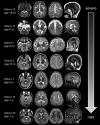RARS1-related hypomyelinating leukodystrophy: Expanding the spectrum
- PMID: 31814314
- PMCID: PMC6952319
- DOI: 10.1002/acn3.50960
RARS1-related hypomyelinating leukodystrophy: Expanding the spectrum
Abstract
Objective: Biallelic variants in RARS1, encoding the cytoplasmic tRNA synthetase for arginine (ArgRS), cause a hypomyelinating leukodystrophy. This study aimed to investigate clinical, neuroradiological and genetic features of patients with RARS1-related disease, and to identify possible genotype-phenotype relationships.
Methods: We performed a multinational cross-sectional survey among 20 patients with biallelic RARS1 variants identified by next-generation sequencing techniques. Clinical data, brain MRI findings and genetic results were analyzed. Additionally, ArgRS activity was measured in fibroblasts of four patients, and translation of long and short ArgRS isoforms was quantified by western blot.
Results: Clinical presentation ranged from severe (onset in the first 3 months, usually with refractory epilepsy and early brain atrophy), to intermediate (onset in the first year with nystagmus and spasticity), and mild (onset around or after 12 months with minimal cognitive impairment and preserved independent walking). The most frequent RARS1 variant, c.5A>G, led to mild or intermediate phenotypes, whereas truncating variants and variants affecting amino acids close to the ArgRS active centre led to severe phenotypes. ArgRS activity was significantly reduced in three patients with intermediate and severe phenotypes; in a fourth patient with intermediate to severe presentation, we measured normal ArgRS activity, but found translation mainly of the short instead of the long ArgRS isoform.
Interpretation: Variants in RARS1 impair ArgRS activity and do not only lead to a classic hypomyelination presentation with nystagmus and spasticity, but to a wide spectrum, ranging from severe, early-onset epileptic encephalopathy with brain atrophy to mild disease with relatively preserved myelination.
© 2019 The Authors. Annals of Clinical and Translational Neurology published by Wiley Periodicals, Inc on behalf of American Neurological Association.
Conflict of interest statement
There are no conflicts of interest directly related to this work.
Figures



Similar articles
-
RARS1-related hypomyelinating leukodystrophy-9 (HLD-9) in two distinct Iranian families: Case report and literature review.Mol Genet Genomic Med. 2024 Apr;12(4):e2435. doi: 10.1002/mgg3.2435. Mol Genet Genomic Med. 2024. PMID: 38618971 Free PMC article. Review.
-
RARS1-related developmental and epileptic encephalopathy.Epilepsia Open. 2023 Sep;8(3):867-876. doi: 10.1002/epi4.12751. Epub 2023 May 5. Epilepsia Open. 2023. PMID: 37186453 Free PMC article. Review.
-
Mutations in RARS cause hypomyelination.Ann Neurol. 2014 Jul;76(1):134-9. doi: 10.1002/ana.24167. Epub 2014 May 16. Ann Neurol. 2014. PMID: 24777941
-
A recurrent de novo mutation in TMEM106B causes hypomyelinating leukodystrophy.Brain. 2017 Dec 1;140(12):3105-3111. doi: 10.1093/brain/awx314. Brain. 2017. PMID: 29186371 Free PMC article.
-
Distinct pathogenic mechanisms of various RARS1 mutations in Pelizaeus-Merzbacher-like disease.Sci China Life Sci. 2021 Oct;64(10):1645-1660. doi: 10.1007/s11427-020-1838-2. Epub 2021 Jan 28. Sci China Life Sci. 2021. PMID: 33515434
Cited by
-
Biallelic PI4KA variants cause neurological, intestinal and immunological disease.Brain. 2021 Dec 31;144(12):3597-3610. doi: 10.1093/brain/awab313. Brain. 2021. PMID: 34415310 Free PMC article.
-
Homozygous EPRS1 missense variant causing hypomyelinating leukodystrophy-15 alters variant-distal mRNA m6A site accessibility.Nat Commun. 2024 May 20;15(1):4284. doi: 10.1038/s41467-024-48549-x. Nat Commun. 2024. PMID: 38769304 Free PMC article.
-
Mutation in PYCR2 gene and hypomyelinating leukodystrophy in children: a case report study.Ann Med Surg (Lond). 2023 Apr 15;85(5):2177-2179. doi: 10.1097/MS9.0000000000000684. eCollection 2023 May. Ann Med Surg (Lond). 2023. PMID: 37228935 Free PMC article.
-
Polymerases and DNA Repair in Neurons: Implications in Neuronal Survival and Neurodegenerative Diseases.Front Cell Neurosci. 2022 Jun 30;16:852002. doi: 10.3389/fncel.2022.852002. eCollection 2022. Front Cell Neurosci. 2022. PMID: 35846567 Free PMC article. Review.
-
RARS1-related hypomyelinating leukodystrophy-9 (HLD-9) in two distinct Iranian families: Case report and literature review.Mol Genet Genomic Med. 2024 Apr;12(4):e2435. doi: 10.1002/mgg3.2435. Mol Genet Genomic Med. 2024. PMID: 38618971 Free PMC article. Review.
References
-
- Pouwels PJ, Vanderver A, Bernard G, et al. Hypomyelinating leukodystrophies: translational research progress and prospects. Ann Neurol 2014;76:5–9. - PubMed
-
- Pelizaeus F. Ueber eine eigenthümliche Form spastischer Lähmung mit Cerebralerscheinungen auf hereditärer Grundlage. Arch Psychiatr Nervenkr 1885;16:698–710.
-
- Merzbacher L. Eine eigenartige familiär‐hereditäre Erkrankungsform (Aplasia axialis extracorticalis congenita). Zeitschr Ges Neurol Psychiatr 1910;3:1–134.
-
- Kevelam S, Steenweg M, Srivastava S, et al. Update on leukodystrophies: a historical perspective and adapted definition. Neuropediatrics 2016;47:349–354. - PubMed
Publication types
MeSH terms
Substances
Grants and funding
LinkOut - more resources
Full Text Sources
Molecular Biology Databases
